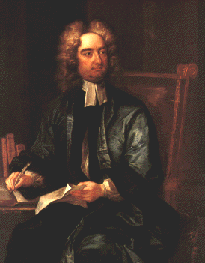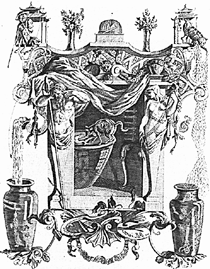Disciplined
Invention, Nature, Wit, & Heroic Couplet
-
Disciplined Invention: "The poet must
have 'invention,' the gift of finding materials for his poems--fictional,
but representative, images of human actions and of the world in which those
actions take place; and he must vivify, heighten, and order those materials
that they seem true pictures of what is, or might or ought to be, or of
the evil and folly that we should avoid.
-
Nature--the universal, permanent, and representative
elements in the moral and intellectual experience of men. External
nature--the landscape--both as a source of aesthetic pleasure and as an
object of scientific inquiry or religious contemplation attracted the attention
of Englishmen throughout the 18th century, But Pope's injunction
to the critic, 'First follow Nature,' has primarily human nature
and human experience in view." Scientifically, Newton
also reinforced the idea of Nature as order.(1685)
-
Wit--quickness and liveliness of mind, inventiveness,
a readiness to perceive resemblances between things apparently unlike and
so to enliven literary discourse with appropriate images, similes, and
metaphors. An excess of imagination was considered dangerous
to sanity, and in literature to lead away from Nature and truth to falsehood
and such violent and farfetched conceits as we find in the poetry of Donne
of Crashaw at their boldest. One task of the age was to tame what
seemed the wildness of metaphysical wit into the more reasonable and decorous
wit ...So Pope insists in the Essay on Criticism ll. 80-83, on the
necessity of a harmonious union of judgment and fancy (which he calls "wit")
in a work of literature. (1687)
-
Heroic Couplet
"The simplest form of stanza is the couplet;
it is simply two lines rhyming together. . . . when [a single couplet]
includes a complete unified thought, ending with a terminal mark of punctuation,
it is called a closed couplet. [Heroic couplet] is
a strictly iambic pentameter couplet, strongly end-stopped, and
with the couplets prevailingly closed. Heroic couplets generally
are varied by means of a decided caesura (strongly grammatical pause
within a line), and limited to precisely ten syllables per line.
The heroic couplet is the principle form of English neoclassical style("Poetic
Forms and Literary Terminology" The Norton Anthology of English
Literature vol. 1. 3rd ed. p. 2471).
|



![]()